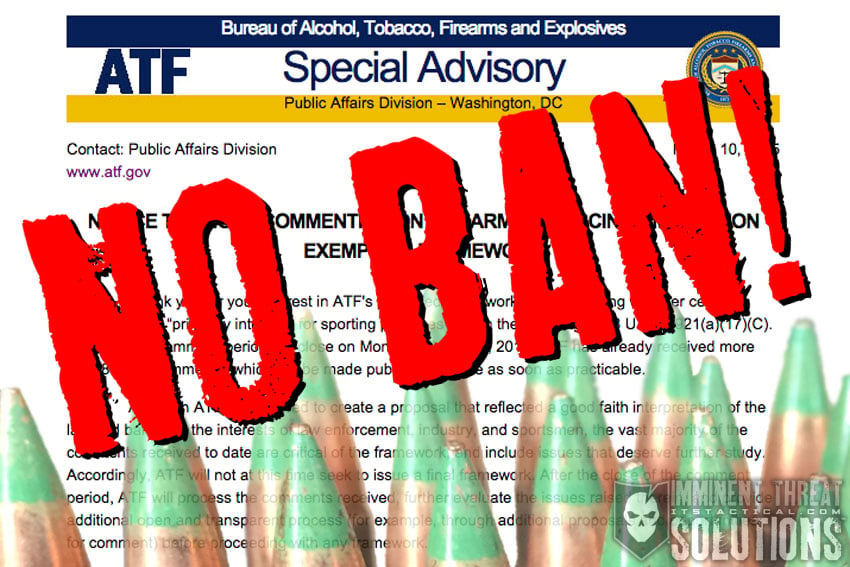Military Ammunition and Why Green Tip M855 is Not Armor Piercing
Military Ammunition and Why Green Tip M855 is Not Armor Piercing
Over the weekend I attended the final hours of my NRA RSO (Range Safety Officer), Rifle and Shotgun Instructors training. While I won’t get into the NRA’s embargo on the word “weapon,” or that a few instructors freaked out when I carried a firearm with the muzzle pointed at the ground, I did learn something from our readers on Facebook I’d like to share with everyone about M855 ammunition.
Throughout my time in the Military, I’d always referred to M855/SS109 5.56 Ammunition (Green Tip) as armor piercing rounds or AP. For the life of me I can’t recall where I first heard that mentioned, but it was fairly common for it to be referred to as that.
One of the final taskers for the NRA courses was to construct a training aid and you’ll see a photo below of what I put together.
Armor Piercing?
 As you’ll see, I have the green tip marked “AP Tip,” which is how I explained my training aid to the class as well. (If you’re wondering, it was made from a cardboard tube, floral foam, paint and a little creative thinking).
As you’ll see, I have the green tip marked “AP Tip,” which is how I explained my training aid to the class as well. (If you’re wondering, it was made from a cardboard tube, floral foam, paint and a little creative thinking).
After a few people pointed out that M855 isn’t AP in the Facebook comments of the photo I posted, I started doing some digging. It turns out that sure enough, M855 was removed from the ATF’s list of AP rounds. I haven’t been able to track down when this change took place, but I thought it was important to share to all those that have considered M855 to be AP rounds like I did.
While having a Steel Penetrator Tip, this doesn’t constitute M855/SS109 as “Armor Piercing.” The round was designed for increased penetration at longer ranges to combat SAW (Squad Automatic Weapon) issues though.
Things may or may not be clearer once you read how the Federal Government defines AP ammunition in 18 USC sec. 921(a)(17).
Definition
(17)(A) The term “ammunition” means ammunition or cartridge cases, primers, bullets, or propellent powder designed for use in any firearm.
(B) The term “armor piercing ammunition” means –
(i) a projectile or projectile core which may be used in a handgun and which is constructed entirely (excluding the presence of traces of other substances) from one or a combination of tungsten alloys, steel, iron, brass, bronze, beryllium copper, or depleted uranium; or
(ii) a full jacketed projectile larger than .22 caliber designed and intended for use in a handgun and whose jacket has a weight of more than 25 percent of the total weight of the projectile.
(C) The term “armor piercing ammunition” does not include shotgun shot required by Federal or State environmental or game regulations for hunting purposes, a frangible projectile designed for target shooting, a projectile which the Attorney General finds is primarily intended to be used for sporting purposes, or any other projectile or projectile core which the Attorney General finds is intended to be used for industrial purposes, including a charge used in an oil and gas well perforating device.
What does all that mean?

A few things to take note of is that the classification as “armor piercing” is for bullets only, not the complete cartridge. Despite the mention of handgun caliber above, you can take that to mean that it’s a round that has been made as a handgun caliber at some point.
The bullet (projectile) must also have a core made entirely out of the metals listed above, or be a full jacketed bullet with a jacket weighing more than 25% of its overall weight. This means that the SS109/M855 bullets wouldn’t be covered, as their cores are partly steel, and partly lead. Lead isn’t listed in the metals above. Furthermore, as you’ll see in the list below, the ATF has specifically stated that the SS109/M855 bullets are exempted from AP status.
ATF AP Classified Rounds
- All KTW, ARCANE, and THV ammo
- Czech made 9mm Para. with steel core
- German made 9mm Para. with steel core
- MSC .25 ACP with brass bullet
- BLACK STEEL armor and metal piercing ammunition
- 7.62mm NATO AP and SLAP
- PMC ULTRAMAG with brass bullet (not copper)
- OMNISHOCK .38 Special with steel core
- 7.62×39 ammo with steel core bullets
ATF Exempted Rounds
- 5.56 SS109 and M855 NATO rounds, with steel penetrator tip.
- .30-06 M2 AP ammo
Hopefully that clears up some confusion for you like it did for me. You can rest easy that when a range calls for no AP rounds that you’ll be safe using M855 if desired. If you’re in the market for ammo, be sure to check out our sponsor Lucky Gunner for great online ammo prices!
[flickrset id=”72157626901980062″ thumbnail=”thumbnail” photos=”” overlay=”true” size=”medium”]











Discussion